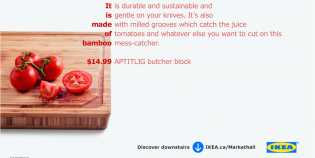For two weeks at the end of January, a six-minute YouTube video of a bride going berserk because of her bad wedding day hairdo captured the attention of millions. The seemingly homemade video, called “Bride Has Massive Hair Wig Out,” was featured on TV shows like Good Morning America, along with dozens of newspapers and hundreds of blogs. Everyone wanted to know if it was real or staged. As it turned out, it was faked. Toronto agency Capital C created the video to promote Sunsilk shampoo. Here’s how they came up with the idea:
The product: Unilever’s Sunsilk shampoo-a 50-year-old brand popular in Europe, Latin America and Asia (it has a 45% market share in India) that wasn’t sold in North America.
The consumer: Katie, a fictitious 25-year-old who represented the typical Sunsilk target consumer. Katie’s profile was developed in panel discussions that PR firm Harbinger Co-mmunications conducted with 15 women. One key insight: When Katie had bad hair, her whole day could spiral into a crisis.
The launch: Sunsilk arrived in Canada and the U.S. in spring 2006, with creative by JWT introducing the term “hairapy”-a play on therapy for hair. TV spots featured a gay man telling the Katie character to “get yourself some hairapy.” In Canada, Capital C developed a program in which “hairapists” hit the street to talk to the Katies of the world. The campaign was Unilever Canada’s biggest brand launch ever, and sales took off.
The problem: How to maintain the momentum Sunsilk had built after the initial marketing push ended. “When we started to pull back the investment, we got lost in a sea of clutter,” says Tony Chapman, CEO of Capital C.
The idea: “Attention is the oxygen of brand building,” Chapman notes, and by January 2007, Sunsilk was looking for a new way to get Katie’s attention. Fortunately, JWT found it in an old English expression it incorporated into a TV ad showing a woman having a bad hair day. “If hair is wigging you out, you need hairapy,” the voiceover said. “Wigging out” was such a great expression, says Chapman, that the agency came up with an outlandish idea: What if they could seed the term deeper into popular culture? “We wanted to make it so that if you thought of “wig out” you would think of Sunsilk, just like if you thought of dandruff you thought Head & Shoulders,” Chapman says.
The shoot: Cap C’s strategy was to make 12 to 20 viral videos that would be posted on YouTube. Each would feature a Katie-type character having a bad hair day in an already stress-ful situation. In one clip she would meet her mother-in-law for the first time; in another she’d wig out while on the job.
The first video shot was of a bride on her wedding day. It turned out to be the only one Cap C needed to make. The video, which cost $5,000 to produce, was shot in a Toronto hotel in one take and showed the bride (played by 22-year-old actress Jodi Behan) going ballistic on her wedding day. Though her bridesmaids try to calm her down, she’s so distraught by her bad hair she grabs a pair of scissors and starts cutting it off. (Behan wasn’t wearing a wig either, she actually chopped her locks.)
Two weeks on YouTube: The day after the shoot, on Jan. 19, Capital C posted the full six-minute video “Bride Has Massive Hair Wig Out,” on the popular online video site. The scene was shot to look as realistic as possible and made no mention of Sunsilk. Behan shrieks hysterically throughout. On its first day, the video was viewed by only 300 people. By 4 p.m. the following Monday, 23,000 people had watched it. Then, as Chapman explains, the “tipping point” occurred: American Idol host Ryan Seacrest mentioned it on his morning radio show in Los Angeles, and pretty soon everyone from Howard Stern to Dr. Phil was commenting on the video and trying to figure out whether it was real. By Jan. 29, the video had been viewed 1.3 million times; three days later, it was 2.8 million.
The reveal: Chapman says his agency planned to reveal the video was a fake, but never got the chance. In a story that appeared on Jan. 31, director Norman Jewison told the Toronto Star he was so impressed with the bride’s performance that if the video wasn’t real, he’d hire the actress for one of his films. Family and friends of Behan quickly blew her cover, and on Feb. 1 the Star reported the video was a hoax, Unilever issued a somewhat apologetic press release saying it was behind the video, which Capital C then pulled from YouTube.
Did it work? Geoff Craig, vice-president and general manager of home and personal care at Unilever, says his company views the video as one phase in linking the term “wig out” to Sunsilk, and future marketing will further link the two. While Craig says the brand’s market share has increased, he doesn’t attribute it directly to either the YouTube post or the resulting publicity.
Chapman, though, points out that the initial goal was to make wig out part of pop culture vernacular. In that respect his agency succeeded. Two weeks after the video was taken off YouTube, pop princess Britney Spears cut off her hair. The resulting headlines said it all: “Britney wigs out.”










